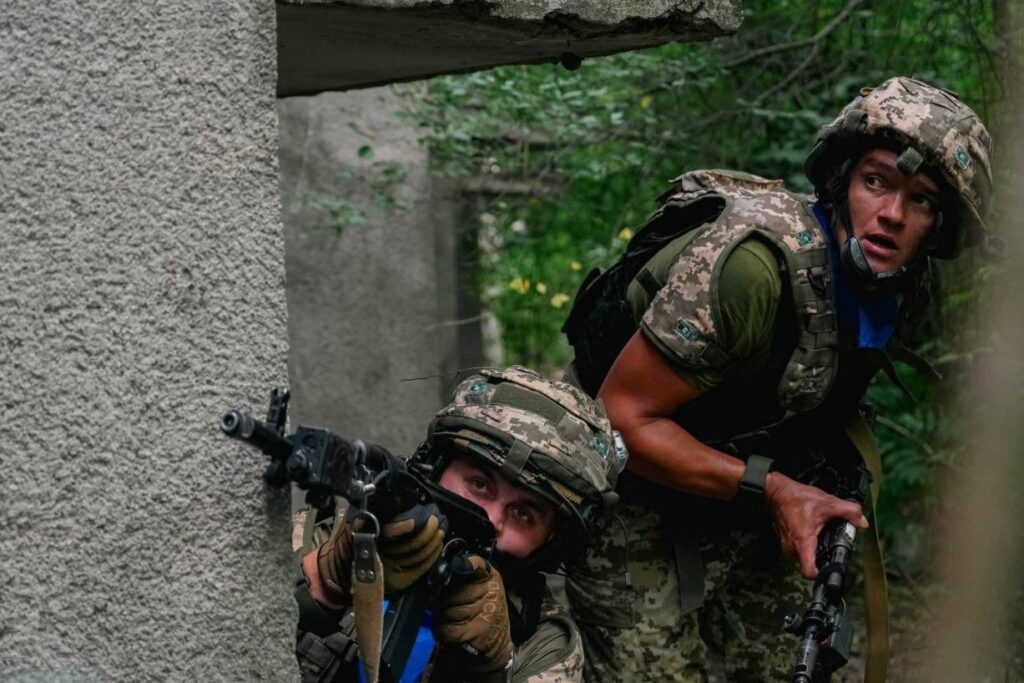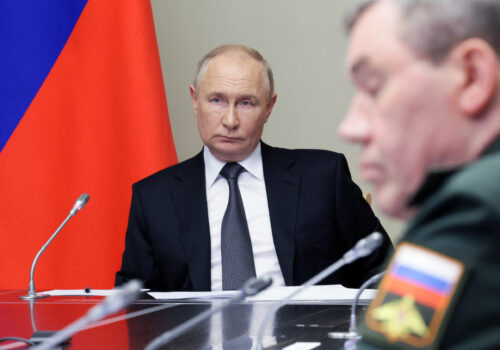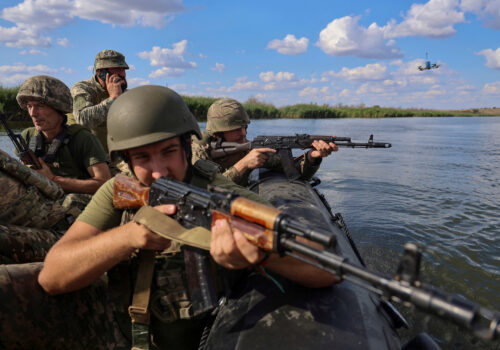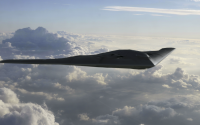How Ukraine’s Kursk incursion echoes the Gettysburg campaign
In the early days of Ukraine’s incursion into Russia’s Kursk region, the Atlantic Council’s Daniel Fried likened Ukraine’s bold maneuver to George Washington’s historic raid across the Delaware River. At the time, this analogy was fitting, given the information available and the perceived objectives. However, as the operation approaches the six-week mark, it has become clear that this incursion is not merely a raid—a military operation characterized by temporary seizure of territory and a planned withdrawal. Ukraine has had multiple opportunities to withdraw, yet it remains.
At this point, a different historical analogy may provide some insights: the Battle of Gettysburg.
After more than two years of grinding conflict, Russia appears content to wear down Ukraine through a war of attrition. However, Ukraine understands that it cannot sustain a prolonged conflict given its more limited resources, smaller population, and lack of naval power. On August 6, leveraging operational security and other low-tech tactics, Ukrainian forces launched a daring offensive, advancing northward from eastern Ukraine into Russian territory.
This offensive is not a traditional raid, and Ukraine cannot realistically aim to permanently annex Russian territory or extend the operation much further. Instead, it increasingly appears that the objectives are to disrupt Russian military logistics, force a strategic realignment, demoralize the Kremlin, erode domestic support within Russia, bolster prospects for international aid, and create leverage—objectives strikingly similar to those held by the Confederacy in its ill-fated campaign at Gettysburg.
In 1863, the Confederacy faced a similar dilemma to that of Ukraine. After years of war, Confederate leaders understood that the Union’s larger population, industrial capacity, and naval superiority would inevitably wear them down. Seeking to seize the initiative and shift the momentum of the war, the South launched a bold offensive into northern territory, aiming to win a decisive battle that could demoralize the North, erode domestic political support, bolster prospects for international aid, and create leverage for negotiating an acceptable peace settlement. In June 1863, General Robert E. Lee’s Army of Northern Virginia initiated the Gettysburg campaign by moving northward from central Virginia. Utilizing the Shenandoah Valley as a natural corridor, Lee’s forces shielded their movements from Union observation, crossed the Potomac River into Maryland, continued into southern Pennsylvania, and clashed with the Union at Gettysburg.
Confederate objectives at Gettysburg
- Political impact: A triumph on Union soil could have demoralized the North, intensified pressure on President Abraham Lincoln, empowered Peace Democrats (aka Copperheads), and potentially shifted the war’s political landscape.
- International recognition: The South hoped that success might persuade Britain and France to recognize the Confederacy.
- Further military campaigns: Victory could have paved the way for additional Confederate offensives, forcing the Union to stretch its defenses and reconsider its strategic objectives.
- Impact on morale and military strategy: A Confederate win could have shaken Union morale, leading to significant changes in leadership and military tactics, echoing the Union turmoil seen throughout the war.
- Leverage for negotiation: Holding northern territory might have given the South some additional leverage in peace talks.
Strategic parallels and potential objectives in Ukraine
- Political impact: A significant Ukrainian victory, combined with Russia’s embarrassment, could demoralize Russian forces, boost Ukrainian morale, intensify domestic and international pressure on Russian leadership, and enhance Ukraine’s leverage in negotiations or potential peace talks.
- International recognition: Success on Russian soil could increase international support for Ukraine, resulting in continued military and economic aid while further isolating Russia diplomatically. In the short term, it could also prompt reconsideration of restrictions on the use of foreign-supplied weapons in Russian territory, enhancing Ukraine’s operational capabilities.
- Further military campaigns: Ukrainian success could force Russia to redeploy some of its troops, limiting Russia’s ability to advance in the Donbas and perhaps providing time and space for Ukraine to strengthen its defensive position in the region.
- Impact on morale and military strategy: Major Ukrainian victories could significantly boost national unity and morale, encouraging volunteer enlistment and drawing stronger international support.
- Bringing the fight to Russia: While early successes could strengthen Ukraine’s position, they may also force the Kremlin to resource another front, which would further diminish public support and may generate additional leverage for Ukraine.
Just as the Confederacy sought to turn the tide of the war with a daring invasion, Ukraine appears to have adopted a similar strategy to alter the dynamics of its conflict. According to Commander in Chief of the Armed Forces of Ukraine Oleksandr Syrsky, Ukraine’s advance has, to date, secured one thousand square kilometers or more of Russian territory—a success that could provide Ukraine with critical strategic leverage.
However, there are notable differences between the two campaigns. For the first time since World War II, a foreign force occupies Russian territory, giving Ukraine a chance to consolidate its gains, strengthen its defenses, and prepare for future operations—advantages Lee never enjoyed. Ukraine has, so far, avoided significant tactical missteps, such as Pickett’s Charge. Of more strategic importance, Russia has refrained from making the Kursk region decisive, with Putin hesitating to commit to a full-scale counteroffensive as the Union did at Gettysburg.
Despite Ukraine’s successes in Kursk so far, its position remains precarious. The resources invested in this incursion are substantial, and if Russia’s response continues to be limited, Ukraine’s forces may be more effectively used elsewhere. Furthermore, an encirclement or defeat of Ukrainian forces in Kursk could ultimately be as catastrophic for Ukraine as Lee’s defeat at Gettysburg was for the Confederacy. The complexities of modern warfare, combined with the unique challenges of this conflict, make such scenarios plausible. Any political gains are now on the Ukrainian generals to hold. Those generals now face critical decisions: hold the territory, withdraw and strike elsewhere, or strategically redeploy their forces.
Ukraine’s incursion has already shifted the dynamics of the war, offering the potential for Ukraine to regain some momentum. This operation has compelled both sides to reassess their priorities, strategies, and tactics. For those seeking to understand the broader implications, viewing the incursion through the lens of Gettysburg offers a relevant framework for interpreting Ukraine’s motivations, possible outcomes, and long-term strategic objectives.
Lieutenant Colonel Gregg F. Curley is the 2024-2025 US Marine Corps fellow at the Atlantic Council’s Scowcroft Center for Strategy and Security.
Further reading
Fri, Aug 30, 2024
Dispatch from Kyiv: How Ukraine’s incursion into Russia has changed the war
New Atlanticist By John E. Herbst
On an Atlantic Council trip to Kyiv, Ambassador John E. Herbst takes stock of how Ukrainians view the war now that their forces have seized more than 460 square miles of Russian territory.
Wed, Aug 21, 2024
Invasion? What invasion? Putin is downplaying Ukraine’s Kursk offensive
UkraineAlert By Peter Dickinson
Vladimir Putin’s efforts to downplay Ukraine’s invasion of Russia have severely dented his strongman image and make a mockery of the West’s escalation fears, writes Peter Dickinson.
Fri, Aug 9, 2024
Is Ukraine’s raid into Russia a ‘crossing the Delaware’ moment?
New Atlanticist By Daniel Fried
With echoes of earlier raids, Ukraine’s recent push into the Kursk region of Russia shows its tactical cunning, audacity, and tenacity against a superior foe.
Image: Ukraine.- In these photos, members of the Ukrainian Military Forces are deployed in the border area amid the conflict with Russia on August 12, 2024. More than 76,000 people have been evacuated from the border areas with Ukraine in Russia’s Kursk region, the local Emergencies Ministry reported, following Ukraine’s incursion into the region this week. Handout / Latin America News Agency via Reuters Connect.






